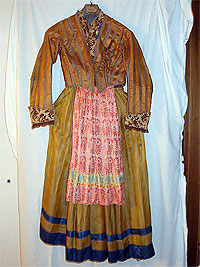Wholesome Regionalism and Leveling Cosmopolitanism
Written by Plinio Corrêa de Oliveira
The following text is taken from an informal lecture Professor Plinio Corrêa de Oliveira gave on December 10, 1970. It has been translated and adapted for publication without his revision. – Ed.
There is an interesting passage in Saint Theresa’s famous Story of a Soul, in which she speaks of the cultural atmosphere that existed in Loreto when, as a child, she went on pilgrimage with her family:
“I was indeed happy when on the way to Loreto. Our Lady has chosen an ideal spot in which to place her Holy House. Everything is poor, simple, and primitive; the women still wear the graceful dress of the country and have not, as in the large towns, adopted the modern Paris fashions. I found Loreto enchanting. And what shall I say of the Holy House? I was overwhelmed with emotion when I realized that I was under the very roof that had sheltered the Holy Family.”1
This excerpt gives one a small taste of the sublime atmosphere the Holy House of Loreto created around itself. Furthermore, one perceives that the graces brought by the Holy House also formed the souls and customs of the local population.
At that time, traditional clothing was still worn by the people in many regions of Europe, and Saint Theresa opines that the local ladies did well to conserve their traditional dress.
She eulogizes the women for using the simple clothing of a bygone era, rather than wearing the latest Paris fashions. She believes that healthy regionalism is preferable to cosmopolitanism. This is a Counter-revolutionary position in face of the Revolution’s efforts to finish with regional characteristics. 2
In this, Saint Theresa’s profoundly Counter-revolutionary soul shows itself. Her understanding of the correlation between temporal and spiritual life becomes manifest. She realizes that a good social organization favors the practice of virtue and sanctification. All this is contained in this small but dense excerpt.
Ironically, when she wrote this, certainly she was wearing Parisian fashions, since in France, only country girls wore regional clothing.
While modest, Paris’ fashions favored the leveling effect of cosmopolitanism. Observing the ladies in Loreto, she perceived this, and expressed her love of legitimate regional differences, even while she resigned herself to wearing the chaste clothing, common to her status.
Footnotes
1. T.N. Taylor, ed., Soeur Thérèse of Lisieux, The Little Flower of Jesus (New York: P.J. Kennedy and Sons, 1924), pp. 93-94.
2. The terms “Revolution” and “Counter-revolution” are used here in the sense explained by Prof. Plinio Corrêa de Oliveira in his book, Revolution and Counter-Revolution. In this context the “Revolution” is a five-centuries-old process that seeks to destroy Christian civilization, especially through temporal society. The Counter-revolution, then, is made up of those willing to resist this process of de-Christianization.







